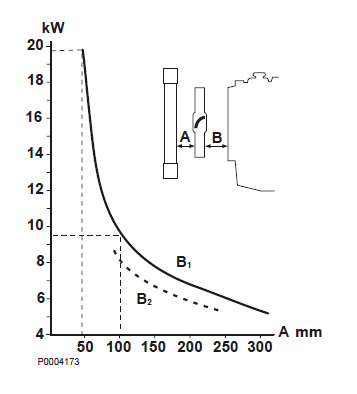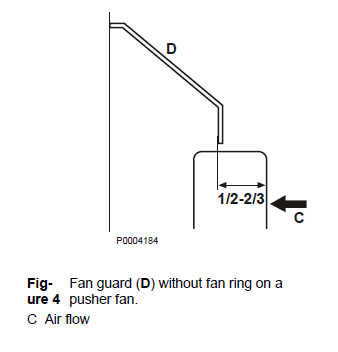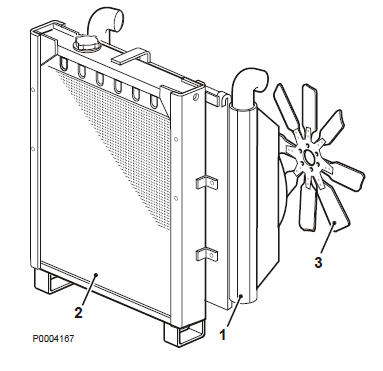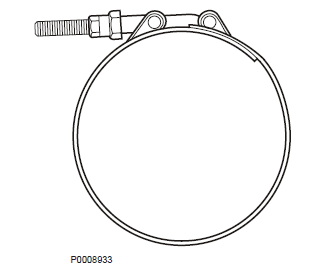Calculation Formulae
Air density
The fan plot only applies to a given air temperature, normally 20 °C (68 °F), which gives an air density of 1.2 kg/m3 (0.075 lb/ft.3). If the plot is not drawn for 20 °C the actual temperature and density must be specified. The pressure from the fan plot must be recalculated for other temperatures. If the fan graph applies to an air density of ρ0 and the actual air density is ρ1, the pressure ρ0 from the graph is recalculated as follows:
p1 ρ1
–– = ––
p0 ρ0
ρ = air density (kg/m3)
t = air temperature (°C)
Air density can be calculated by:
index 0: from the diagram
index 1: actual value
ρ1 273 + t0
–– = –––––––
ρ0 273 + t1
Fan speed
The following formula may be used to determine the fan plot for a fan speed other than the one drawn:
qA2 n2
––– = ––
qA1 n1
qA = air flow (m3/s)
p = pressure increase (Pa)
n = fan speed (rpm).
p2 / p1 = (n2 / n1)2
Fan power consumption at a different fan speed can be calculated by:
p2 / p1 = (n2 / n1)3
P = fan power consumption (W)
Efficiency
Fan efficiency can be calculated as follows:
p x qA
η = –––––
P
Fan speed
Fan rpm ratios for different engines are specified in Sales Support Tool, Partner Network. Fan noise and power consumption depend largely on fan speed. Fan power consumption is proportional to fan speed cubed, as shown in the preceding formulae. This means that if fan speed increases by 10 %, fan power consumption increases by 33 %. Fan noise depends to a great extent on vortices generated by the blade tips. A blade tip speed of max 90 m/s (295 ft./s) (circumferential speed) is recommended in order to achieve a low noise level. Generally a low fan speed and a large fan diameter are recommended in order to create the required air p = increase in static pressure (Pa) flow.
Fan location

The optimal fan location is in the center of the radiator. The fan must rotate over as large a radiator core surface area as possible, but fan diameter must not be greater than radiator core width or height. Fan location on the engine is determined by the type of fan drive. All Volvo Penta engines have belt-driven fans as standard. Some engines for mobile pplications also have crankshaft-mounted fans as an option.
Sucking fan
The distance between the radiator core and the front of the fan is extremely important for air distribution and fan power consumption. It is important that air flow be evenly distributed over the radiator core to achieve the best possible cooling capacity. If the fan is too close to the radiator core the air flow will be more concentrated and the radiator surface will not be fully utilized. The recommended distance (A) is 100–200 mm (3.9 - 7.9"). The minimum permissible distance is 80 mm (3.1").

The graph shows the approximate reduction in fan power consumption when the distance is increased. The distance (B) between the front of the engine and the back of the fan also affects fan power consumption. The illustration shows two examples with two different values for the distance B called B1 and B2, where B2 is greater than B1.The distance is also important for cooling air restriction and a short distance provides greater restriction.
Pusher fan
The distance between the radiator core and the charge air cooler radiator core and the back of the fan is extremely important for air distribution and fan power consumption. It is important that air flow be evenly distributed over the radiator core to achieve the best possible cooling capacity. The recommended distance (A) is 100 mm (3.3").
Fan ring
The function of the fan ring is to increase fan performance and reduce the generation of vortices at the blade tips. The fan's radial and axial location in relation to the fan ring is of extreme importance for its efficiency. The position is also dependent on whether it is a pusher or a sucking fan. Because so many parameters play a role in fan installation it is difficult for Volvo Penta to specify precise measurements if the customer designs his own system with parts other than Volvo Penta's. In general terms fan performance is improved where there is a minimum distance between blade tips and the fan ring subject to the necessary clearance for movement and its effect on the design.
Fan cowl (D)

The function of the fan cowl is to ensure that all air flow from the fan is led to the cooler. This means that the fan cowl must make a good fit with the radiator. If an engine-mounted fan ring is used its seal against the fan cowl must be good. The connection between the fan cowl and the fan ring must be made such that no unnecessary obstacles to air flow are created. Fan guard depth must be adapted to provide the correct distance between the radiator core and the front of the fan.
Charge air cooler

The air-to-air type charge air cooler (1) forms part of both the cooling air and inlet systems. The function of the charge air cooler is to cool the charge air between the turbocharger and the inlet manifold. Air density is thus increased, which provides more oxygen for combustion. Power is therefore increased while exhaust emissions are reduced. The charge air cooler must only use the coldest possible cooling air and the latter must therefore pass through the charge air cooler before it passes the coolant radiator (2). In a sucking fan system the charge air cooler must be located in front of the radiator, and behind the radiator in a pusher fan system. The charge air cooler is manufactured entirely in aluminum. Charge air passes through the heat exchanger in wide aluminum tubes with folded aluminum fins. Extremely high standards of air cleanliness and airtight integrity apply to the charge air cooler. The most important charge air cooler performance factors are temperature efficiency, charge air pressure drop and cooling air pressure drop.
Temperature efficiency is defined as follows:
tL1 - tL2
ηt = ––––––
tL1 - t0
tL1 = charge air temperature before the charge air cooler
tL2 = charge air temperature after the charge air cooler
t0 = cooling air temperature before the charge air cooler
Temperature efficiency depends on charge air flow and cooling air flow for a given charge air cooler. Efficiency increases when charge air flow falls and cooling air flow rises. Volvo Penta charge air coolers for gen sets and stationary TAD engines all have a temperature efficiency of more than 0.9 at maximum engine rating.
The aluminum fins are folded and have a grille. Cooling air is heated when it passes through the
charge air cooler and conditions are thus poorer for the radiator. In an open engine installation there is usually a temperature increase of around 10 °C (50 °F) across the charge air cooler. Cooling air temperature increases overall by approx. 35-45 °C (1.7 - 7.2 °F) across the entire radiator assembly (both the charge air cooler and the radiator). In the case of engines for which Volvo Penta does not supply complete cooling systems, all the technical data required for charge air cooler design is available in Sales Support Tool, Partner Network

NOTICE! VE engines with closed crank case ventilation must have drain taps on the lower charge air cooler tank(s). Water and oil condensate that forms in the charge air cooler must be drained on regular basis. Only high quality jointless piping or aluminum may be used for the pipe run between the turbocharger and the charge air cooler. The inside must be smooth and free from swarf and rust deposits etc. Use only stainless steel clamps of high quality. Clamp width must be at least 15 mm (0.6"). The hose clamp inner diameter must be adapted accurately to the hose diameter, as the clamp working range is small. Minimum clamp belt tensile strength: 400 N/mm2 (58 000 PSI).
For More Volvo Engine workshop information, please visit
Installation of Volvo Diesel Engine
Volvo Engine Mountings for Mobile Installation
Copyright © Guangxi Dingbo Generator Set Manufacturing Co., Ltd. All Rights Reserved | Sitemap
Update cookies preferences